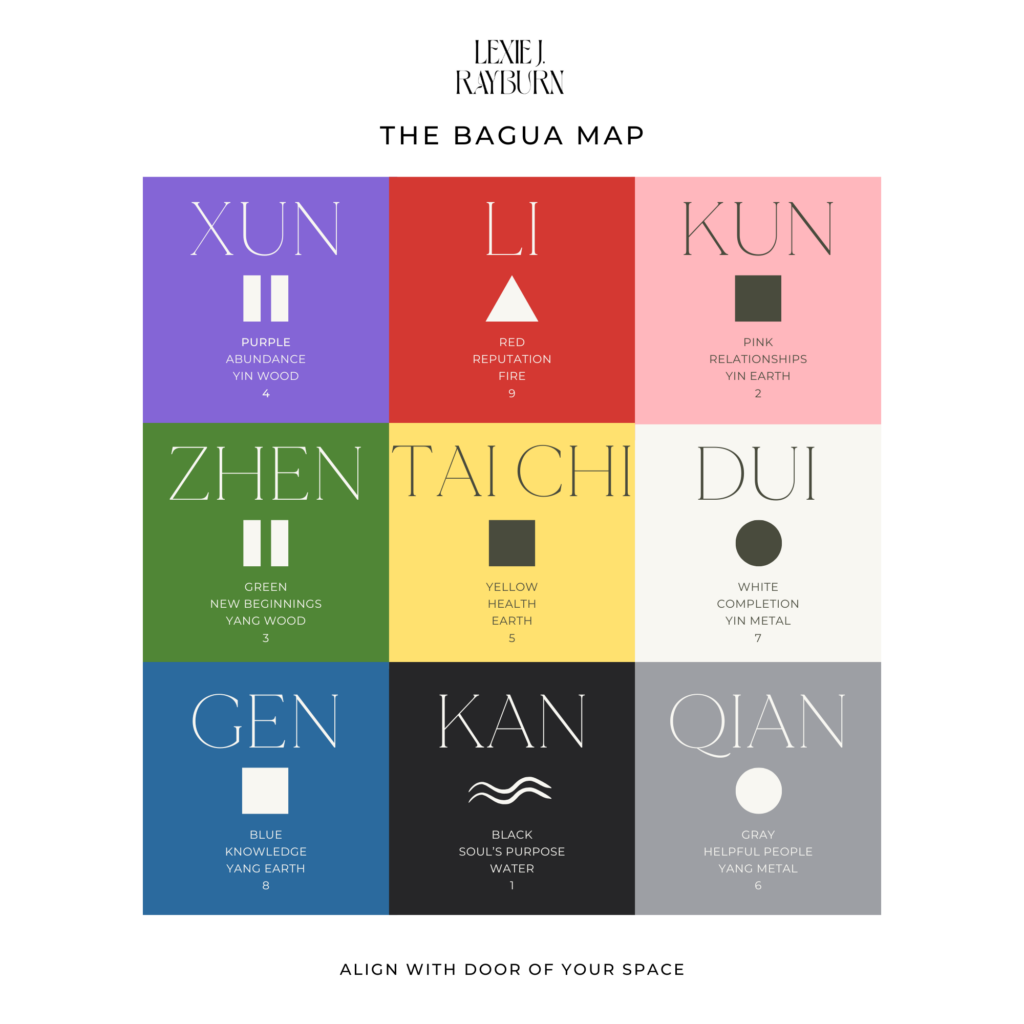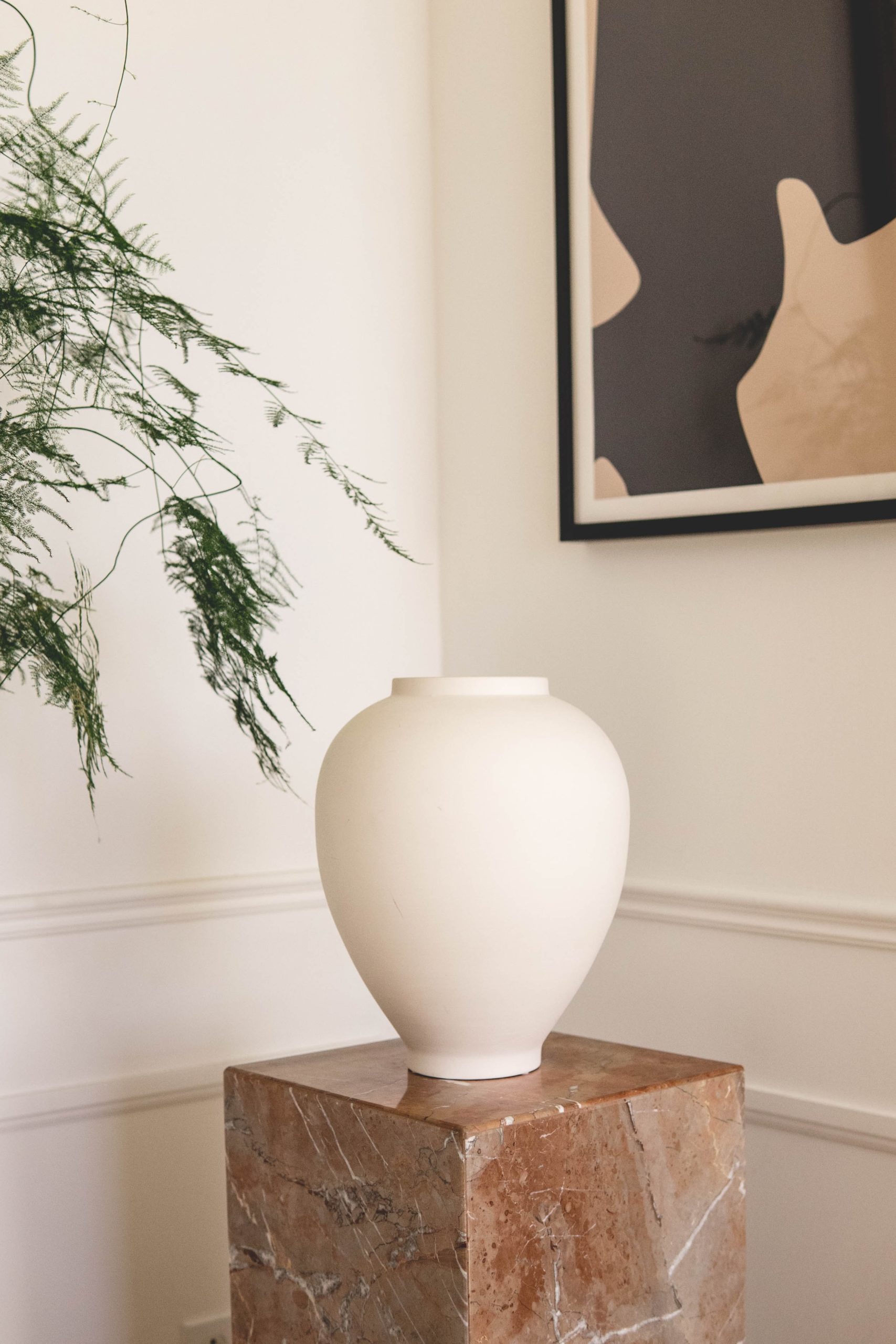The Feng Shui Bagua – Part Two
The Feng Shui bagua is an energy map that is used as a method of understanding how energy – or chi – flows within a space. In today’s post, we’ll discuss each of the nine areas of the bagua and their corresponding traits.
To learn how to lay the bagua on your space, head back to the post, “The Feng Shui Bagua.”
The Bagua
The Feng Shui bagua, pictured below, can be laid on a home, room, piece of furniture or plot of land, and is used as a tool for understanding how energy might be influencing a person’s home or life.
Each area represents a situation in life, such as relationships, fame, career, health, and so on. Additionally, they represent a color, number, shape, time of year, element, and body part. The bagua can be used to identify and enhance areas of a person’s life that they may want to work on, and where energy may be lacking or even overabundant.
Below are each of the nine areas – eight guas and the center Tai Chi – and suggestions of how to activate them. Remember that activation is fueled by intention… without intention, your results may not be as impactful. If you need a refresher on this, click here.
The Bagua

Zhen – New Beginnings – 3
Zhen represents New Beginnings in Feng Shui, or the Family. If you have trouble starting new things or want to focus on supporting the family unit, Zhen is a great gua to activate.
- Element: Yang Wood
- Activation Tip: Introduce the wood element through living plants or water, which feeds wood.
- Color: Green
- Activation Tip: Bring in greens, teals, or blues as accent colors or by painting a wall.
- Shape: Column
- Activation Tip: Add columnar/pillar-like shapes.
- Number: Three
- Season: Spring
- I Ching Trigram: Thunder
- Body Part: Foot, Liver, Gall Bladder
Using the wood element/live plants and water are nice ways to enhance this gua. If this area feels overactive, try adding in elements like fire or metal to soften the presence of wood.
Xun – Wealth – 4
The Xun gua is known as the Wealth or Prosperity/Self-Worth gua. Those who desire more financial stability or who are working on their abundance – personal or financial – can focus on this gua.
- Element: Yin Wood
- Activation Tip: Add living plants or water-like features (water is a wavy shape and the color black). Fake plants are okay where circumstances do not allow for living plants.
- Color: Purple
- Activation Tip: Introduce the color purple, or add greens (wood), blues or blacks (water).
- Shape: Column
- Activation Tip: Use columnar/pillar-like or expansive shapes.
- Number: Four
- Season: Late Spring
- I Ching Trigram: Wind
- Body Part: Hip, Liver, Gall Bladder
Although not a traditional Feng Shui adjustment, crystals such as amethyst (purple) or cirtrine (gold) can be added to activate Xun.
Tai Chi – Health + Center – 5
The Tai Chi is the center of the bagua, meaning it is affected by all of the guas. Because of this, the Tai Chi area relates to your overall health and wellbeing.
- Element: Earth
- Activation Tip: Add earthy elements like earthenware, or heavy objects like boulders or statues.
- Color: Yellow, Brown, Orange
- Activation Tip: Add earthy colors or red tones (red, like fire, feeds the earth element).
- Shape: Square
- Activation Tip: Square objects, like rugs, are a great way to activate the Tai Chi. Additionally, you can add triangular shapes, which represent fire.
- Number: Five
To activate this area of your home, choose just one or two adjustments and set an intention for improving your health/wellbeing in a way that resonates with what you need right now.
Qian – Helpful People + Travel – 6
Qian, or Helpful People/Benefactors, is the gua you will want to activate if you feel like you need to grow your support network or get out in your community. This gua can also represent travel.
- Element: Yang Metal
- Activation Tip: Add metal or heavy objects like statues, or a round metal mirror.
- Color: Gray, White
- Activation Tip: Add colors like gray and white, or metallic colors for the metal element. You can also bring in earthy colors, as earth feeds metal.
- Shape: Circle
- Activation Tip: Circular shapes like round tables can be a nice adjustment for this space.
- Number: Six
- Season: Late Autumn
- I Ching Trigram: Heaven
- Body Part: Head, Lungs
Activating Qian with a wind chime or sound-producing object like tingsha bells can also call in energy to help you be seen and heard.
Dui – Completion + Children – 7
Where Zhen represents New Beginnings and the Family, Dui represents Completion and Children. This may be a good place to start if you have trouble finishing projects.
- Element: Yin Metal
- Activation Tip: Heavy items or metals, or earth-like objects (earth feeds metal).
- Color: White
- Activation Tip: Bring in white or metallic colors, or earthy colors (earth feeds metal).
- Shape: Circle
- Activation Tip: Introduce round/circular shapes.
- Number: Seven
- Season: Autumn
- I Ching Trigram: Lake
- Body Part: Mouth
If this area feels over-active try reducing it by adding elements that calm the metal energy, like water or fire.
Gen – Knowledge – 8
Gen in the Feng Shui bagua is the Knowledge area. This can be activated with the intention of expanding both intellectually and/or spiritually.
- Element: Yang Earth
- Activation Tip: Yang Earth is masculine, firm energy – include heavy or stable objects (think solid, like a mountain).
- Color: Dark Blue
- Activation Tip: Bring in dark blues, or earthy colors for this earth-element gua.
- Shape: Square
- Activation Tip: Add square or flat shapes to activate Gen. Similarly to the Tai Chi, you can add triangular shapes (fire) to feed the earth element.
- Number: Eight
- Season: Late Winter
- I Ching Trigram: Mountain
- Body Part: Hand, Spleen, Pancreas
When making adjustments it can also be helpful to use items that speak to the intention you have set. For example, you can make this area a dedicated space for mindfulness or spiritual growth practices.
Li – Fame – 9
Li, or Fame/Reputation, is an area of the bagua that can be activated with the intentions of being seen and heard, or cultivating passion. Or, on the contrary, can be adjusted with the purpose of softening unwanted attention.
- Element: Fire
- Activation Tip: Add fire, candles for example, or the wood element to feed fire.
- Color: Red
- Activation Tip: Add the color red (like fire), or wood element colors that feed fire (think greens or blues).
- Shape: Triangle
- Activation Tip: Bring in triangular shapes or columnar shapes (think wood feeds fire).
- Number: Nine
- Season: Summer
- I Ching Trigram: Fire
- Body Part: Eyes, Heart
It’s helpful to note that each area of the bagua has a deeper meaning than just its title. For example, this area does not have to be related to only “fame”. When thinking about a fiery person, someone who is fueled with passion and drive may come to mind. Cultivating this energetic, passionate energy can be a great intention for Li.
Kan – Path in Life – 1
Kan represents your Path in Life, or your Career. This area of the Feng Shui bagua can be activated with intentions of growing in/discovering your life’s purpose.
- Element: Water
- Activation Tip: Use the water element in this area of the home, or metal elements.
- Color: Black
- Activation Tip: Add the color black or metallic colors (metal feeds water).
- Shape: Wavy
- Activation Tip: Bring in wavy shapes, think of the flowy shape of water.
- Number: One
- Season: Winter
- I Ching Trigram: Water
- Body Part: Ear, Kidney
Often times this gua can align with the entrance to a home or space. Refer back to, “The Feng Shui Bagua” for more on this. With that in mind, if you want to activate this area of your home, you could paint your front door black, use a black welcome mat, or add a fountain near your front entrance.
Kun – Relationships – 2
Kun is a great place to start if you are hoping to call in a partner, however it can also be used as an area of enhancement for building relationships or practicing more self-love.
- Element: Yin Earth
- Activation Tip: Add earthy elements again, like earthenware, or candles.
- Color: Pink
- Activation Tip: Think pink, like romance, or fiery colors (fire feeds earth).
- Shape: Square
- Activation Tip: Bring in square or flat shapes, as well as triangles (fire feeds earth).
- Number: Two
- Season: Late Summer
- I Ching Trigram: Earth
- Body Part: Reproductive organs, Spleen, Internal Organs
Coming back around to the idea of intention setting, adjusting Kun with symbolic items is a beautiful way to activate the gua. For example, place two bamboo stalks in a single vase to represent an equal, strong relationship with your partner.
Moving Forward
Now that you’ve discovered the meanings behind each area of the Feng Shui bagua, it’s important to move forward with strong intentions. To start, choose no more than three areas that you want to work on. Set intentions behind the adjustments that you make, and allow time to notice the results before making more changes.
Remember that Feng Shui is also a mindfulness practice. Every adjustment becomes more powerful when you’re connecting to it mentally, spiritually and physically.
Want a little more?
Stay tuned for practical, accessible tips to implement Feng Shui in your home by joining the Club Haven Newsletter, and following along on social media @HolisticHavens.
Have more specific questions? Feel free to contact me.

[…] paint colors for an intentionally designed space. Bonus tip – Check out this post about the Feng Shui bagua for placement of colors based on your desired […]
[…] stay tuned for Part Two of the bagua series to learn how to make adjustments in your […]